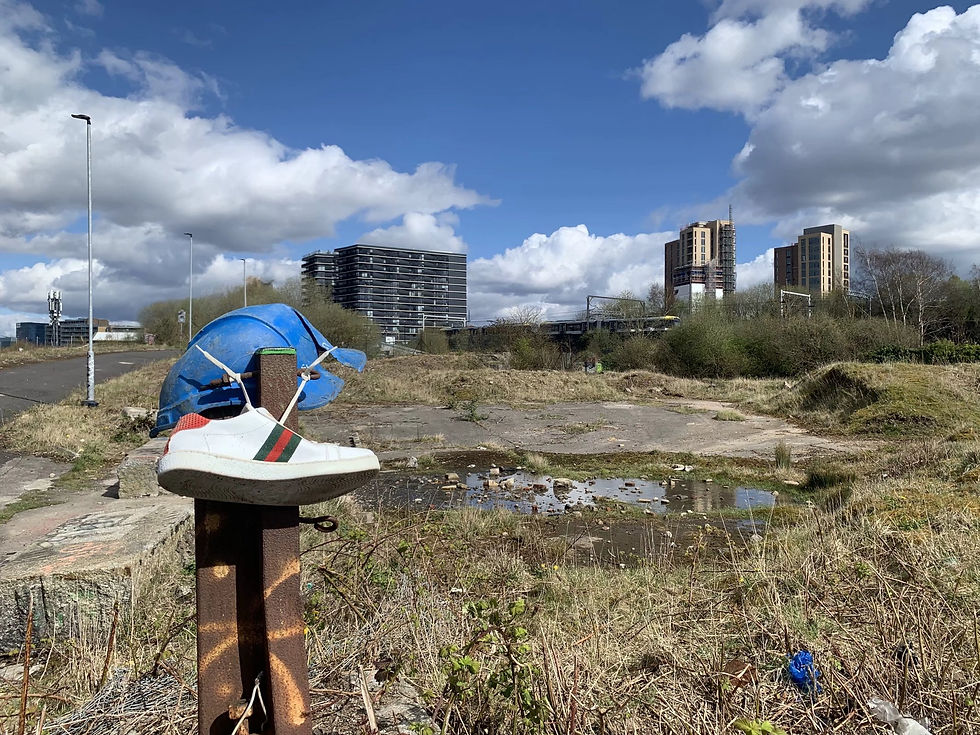The Memory of Pomona
- VICKY MENG
- May 11, 2022
- 3 min read
Once a bustling industrial marina, Pomona is now a peaceful land that belongs to the member of Drosscape. A slender leaf shape of the land is Pomona island. It divides the river Irwell into two canals, one is the manchester ship canal and the other is the Bridgewater canal. Pomona island acts as the invisible boundary between Salford and Manchester, which buffers the waterway. The island is connected to the surrounding area by a pedestrian bridge and a narrow strip of land that curves towards Media City. In addition to the Bridgewater Canal and the Orwell River, the vast spine of the Manchester South Junction Railway runs through the former Docklands, with trams constantly passing by.

Developer Peel L&P plans to transform the site into thousands of homes, shops, offices, leisure facilities, and green spaces over the next few years, with completion expected in 2037. In the current statement, the first phase of development has gradually formed.

In the 1950s, Pomona was an important industrial dock along the Manchester ship canal. Historically, Pomona was once happy land. Before being a marina, Pomona was truly a tourist destination unparalleled in its splendor. Pomona Pleasure Gardens was a major attraction in the mid-1800s. The original name was Cornbrook Strawberry Gardens, the name Pomona is from the lush orchards here echo the Roman goddess of orchards. The orchard was opened in 1845, and was eventually converted into a public zoo and sold the area in 1868. The new owner built a palace on the land, with a large mansion nearby.
In the 1880s, the site was almost surrounded by factories, and it was decided to build several Manchester Canal piers on the site. In the summer of 1887, the palace and gardens were severely damaged by an explosion at a nearby chemical plant. The following year, the garden was closed forever. Since 1894, the island has been the proud port of the city. This was also the competitiveness of Manchester as a commercial center at the time. By the Edwardian era and World War I, the port had also expanded significantly due to increased traffic. The Port of Manchester was particularly busy during World War II and enjoyed a period of prosperity in the following decade.
Today, nature has become the master of Pomona. The island has also gradually evolved into a wild uninhabited island, where it has become a habitat for ducks, geese, and other wildlife. Plants such as shrubs and birch trees grow wildly here, gradually turning the island into color-green.
Pomona is a completely enclosed island, except for the natural barrier of two canals, the entrance is blocked by an iron fence. Therefore, the observation route design starts from the Cronbrook tram station, because it is the starting point of the Pomona strand. When I arrive at the platform, what catches my eye is the fence surrounding the construction machines and warehouses, while the apartments under construction and the graffiti-filled warehouse can also be seen in the distance.

This is the northeast corner of Pomona. As soon as you step out of the subway station, you can see a piece of grass surrounded by fences, and the conspicuous plastic shopping baskets are lying in the grass.

Then, a blue iron gate will be seen directly when looking to the left. Walking towards the blue gate, you find that there are two pieces of the iron fence on the right side of the gate that has been destroyed which allowed one person can pass through. When I set my first step into Pomona, in addition to the once harbor occupied by lush vegetation, there is also fly-tipping everywhere in Manchester.


Head south along the only road, the Pomona strand, lined with lush meadows and wildflowers. The vast lawn can be seen to the end at a glance. The sky, apartments, warehouses, and canals are visible in the distance. Occasionally cracked concrete flats can be seen on the flat grass, which seems to be a square for playing in the past.


Another fly-tipping ground under the tram rail.











Comments